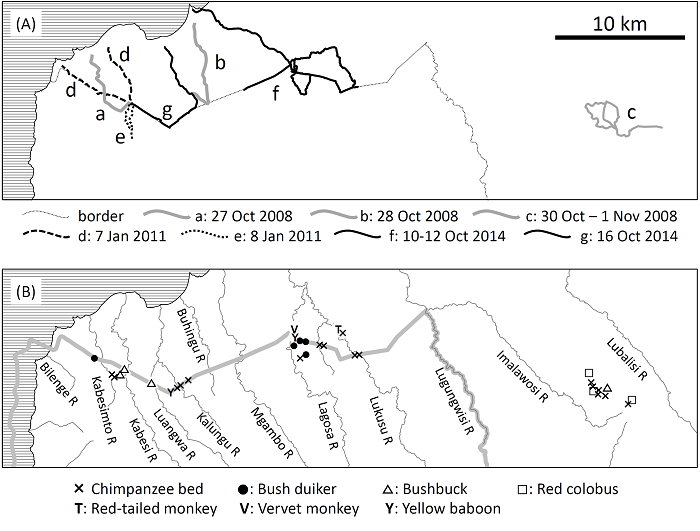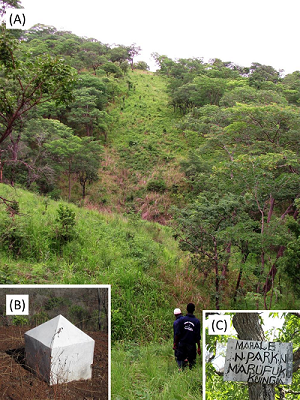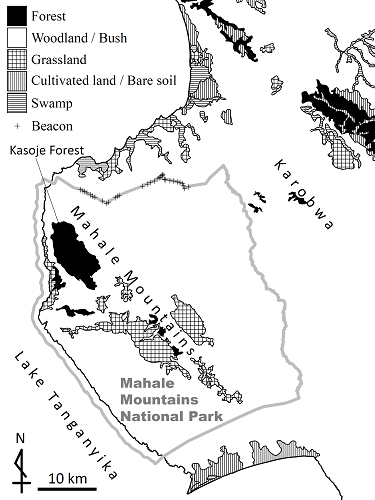|
<ARTICLE>
Chimpanzee distribution around the northern boundary of the Mahale Mountains National Park, Tanzania
Koichiro Zamma1,2,3, Luhunga
Ramadhani3, Bunengwa
Hamisi3, Baraka
Rehani3 & Shaka Kabugonga3
1 Graduate School of Asian and African Area Studies, Kyoto University, Japan 2 Wildlife Research Center, Kyoto University, Japan 3 Mahale Mountains Chimpanzee Research Project INTRODUCTION The Mahale Mountains National Park in Tanzania, established in 1985 (Government Notice 262 1985), conserves wildlife including chimpanzees (Pan troglodytes) (Itoh et al. 2012). An analysis of satellite images suggested that the area inside the northern park boundary had been deforested, but the situation was ambiguous because the boundary on the map did not reflect the location of landmarks in this area (ibid.). Based on a park policy to make the boundary known to local people, a 20-m wide strip along the boundary has been cleared of trees and beacons and park signs have been placed on the border (Figure 1). The aim of this study was to clarify the distribution of chimpanzees and other large mammals inhabiting the area around the northern park boundary.
METHODS This study was conducted in the Mahale Mountains National Park, which is located on the eastern shore of Lake Tanganyika (Nishida 1990). The northwest side of the Mahale Mountains is covered by forest (the Kasoje Forest), which is the main habitat of the Mahale study unit-groups (ibid.). However, most of the area in and around the park is covered by miombo woodland and bamboo bush (Kano 1972; Figure 2). There are several rivers in the woodland and bush, and riverine forests are found along some rivers. The Karobwa Hills, which are located to the east of the park, are also covered with miombo woodland, bamboo bush, and forest and are known chimpanzee habitat (Kano 1972; Ogawa et al. 2006). From 2008 to 2014, we conducted surveys around the northern boundary of the park (Figure 3A). The survey distance was measured by GPS (Garmin GPSmap60Cx), and the total distance was 100.7 km (inside the park: 17.2 km, along the park border: 25.5 km, outside the park: 58.0 km; Table 1).
We recorded the numbers and the positions of chimpanzee beds and large mammals observed during our surveys. When we found animal feces, we identified the species based on the shape and size of the droppings. The positions of beacons were also measured using GPS.
We adopted Kano's method to estimate the population
density of chimpanzees: density (⁄km2) = (number of
beds detected)/(survey distance [km]) (width of survey
route [0.14 km]) (detectability [70%]) (bed duration [180
days]) (Kano 1972). Although two studies have been conducted
to measure the bed decay rate at the west side of
the Mahale Mountains (Ihobe 2005; Zamma & Makelele
2012), no data regarding bed decay rates are available
for the remainder of Mahale. To compare the results of
the present study with those of the previous study (Kano
1972), we used 180 days for our measure of bed duration.

RESULTS We found a total of 88 chimpanzee beds during our surveys (Table 2). The beds were distributed continuously from inside to outside the park, and the beds around the boundary were found near the riverine forests of the Kabesimto, Kalungu, Lagosa, and Lukusu Rivers (Figure 3B). The estimated population densities of chimpanzees were 0.078⁄km2 along the boundary and 0.046⁄km2 inside the park. The estimated density outside the park was 0.038⁄km2, but the density around Karobwa (route c: 0.13⁄km2) was higher than that around the other routes at the north of park boundary (0.0027⁄km2). We observed yellow baboons, bushbucks, bush duikers and bats inside the park and on the park boundary, and red colobus, red-tailed monkeys, vervet monkeys, and bushbucks outside the park (Figure 3B, Table 3). We also confirmed several species of mammals used the habitat based on the fecal evidence (Table 3).
DISCUSSION We estimated the chimpanzee population around the northern park boundary to be similar to that in Ugalla (0.08⁄km2 [Kano 1972]; 0.10/⁄km2 [Yoshikawa et al. 2008]). This similarity is understandable because both the study area and Ugalla is covered with miombo woodland, and the availability of food in these two areas is considered similar. In contrast, the estimated density inside the park is lower than that on the park boundary. This may have been affected by the selection of our survey routes. Ogawa et al. (2013) noted that chimpanzees inhabiting miombo woodland preferred to make beds around forests and/or slopes. The survey routes on the boundary consisted of straight-lines crossing valleys with riverine forests and ridges with slopes, but flatter routes were selected for our surveys inside the park to facilitate walking. Thus, we may have underestimated the population density inside the park. The chimpanzee density in the area outside the northern park boundary was estimated to be lower than that of Karobwa. In western Tanzania, the human population is concentrated to the shore of Lake Tanganyika, and the northern area has been affected by human activity such as deforestation (Itoh et al. 2012). The position of chimpanzee beds along the Lukusu River outside the northern park boundary (Figure 3B) was about 10 km from the shore, and Karobwa is located about 26 km from the shore. Outside the protected area, more chimpanzees are thought to inhabit the area distant from the lakeshore, where human activity is low. It was thought that chimpanzees did not reside between the Mahale Mountains and the Karobwa Hills (Kano 1972). The results of the present study suggest that the riverine forests between these two sites are also suitable habitat for chimpanzees. Thus we assume that the two populations, i.e. those in the Mahale Mountains and the Karobwa Hills, can be connected by chimpanzees inhabiting the stepping-stonelike riverine forests, but 18 km between the Karobwa Hills and the riverine forest on the Lukusu River remain unexplored (Figure 3B). As Nakamura & Fukuda (1999) found chimpanzee beds around the middle part of the eastern park boundary, the connection of the two populations will be clarified by more information about the area around the eastern park boundary. ACKNOWLEDGEMENTS We thank TAWIRI, COSTECH, and TANAPA for research permission and M-GWRC and MMNP for logistic support. We also thank Raymondy Simon, Mohamedi Kalimanzera, Matiasi Jemsi, Haidali Maulidi, Nasolo Maulidi, Chales Williams, Silindila Athumani, and Ramadhani Nyundo for the survey in Karobwa, local people in Katumbi, Nkonkwa, Mgambo, and Lubalisi for their kind help, and T. Nemoto, T. Matsumoto, S. Inoue, M. Otani, S. Hanamura, M. Nakamura, and M. Yoshikawa for their support and advice. This study was supported by the Global Environment Research Fund of the Ministry of Environment, Japan (F-061 to T. Nishida), the Grant-in-Aid for Scientific Research (A) (#19255008 to T. Nishida), JSPS Asia Africa Science Platform Program (to G. Idani). REFERENCES Government Notice No. 262 1985. The national parks ordinance. Gazette of the United Republic of Tanzania, 24:305–306. Ihobe H 2005. Life span of chimpanzee beds at the Mahale Mountains National Park, Tanzania. Pan Afr News 12:10–12. Itoh N, Nakamura M, Ihobe H, Uehara S, Zamma K, Pintea L, Seimon A, Nishida T 2012. Long-term changes in the social and natural environments surrounding the chimpanzees of the Mahale Mountains National Park. In: The Ecological Impact of Long-Term Changes in Africa's Rift Valley. Plumptre AJ (ed), NOVA Science, New York, pp. 249–277. Kano T 1972. Distribution and adaptation of the chimpanzee on the eastern shore of Lake Tanganyika. Kyoto Univ Afr Stud 7:37–129. Ministry of Natural Resources and Tourism, The United Republic of Tanzania 1996. Land Cover and Land Use: Sheets SB-36-5 & SB-36-9. Hunting Technical Services. Nakamura M, Fukuda F 1999. Chimpanzees to the east of the Mahale Mountains. Pan Afr News 6:5–7. Nishida T 1990. A quarter century of research in the Mahale Mountains: an overview. In: The Chimpanzees of the Mahale Mountains: Sexual and Life History Strategies. Nishida T (ed), University of Tokyo Press, Tokyo, pp 285–290. Ogawa H, Moore J, Kamenya S 2006. Chimpanzees in the Ntakata and Kakungu Areas, Tanzania. Primate Conserv 21:97–101. Ogawa H, Yoshikawa M, Idani G 2013. The population and habitat preferences of chimpanzees in non-protected areas of Tanzania. Pan Afr News 20:1–5. Yoshikawa M, Ogawa H, Sakamaki T, Idani G 2008. Population density of chimpanzees in Tanzania. Pan Afr News 15:17–20. Zamma K, Makelele M 2012. Comparison of the longevity of chimpanzee beds between two areas in the Mahale Mountains National Park, Tanzania. Pan Afr News 19:25–28. Back to Contents | ||||||||||||||||||||||||||||||||||||||||||||||||||||||||||||||||||||||||||||||||||||||||||||||||||||||||||||||||||||||||||||||||||||||||||||||||||||||||||||||||||||||||||||||||||||||||||||||||||||||||||||||||||||||||||||||||||||||||||||||||||||

